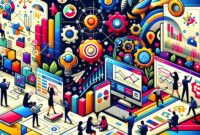
Large-scale decentralization
Not only bitcoin and blockchain solutions will be decentralized, but also other areas of work and life.
For example, Talk’s Ben Rubin develops tools for distributed teamwork (so even the very notion of a meeting can become an archaic notion of the era of centralized jobs). Braintrust uses not only blockchain technology, but its principles to create a network of talent. The platform takes advantage of the network effect and gains value as the number of participants grows.
CashDrop enables anyone (from a fast food kiosk owner to a clothing designer) to create a storefront without relying on traditional fee or commission schemes. Thus, the model in which service providers or landlords (markets, app stores, etc.) retain a percentage of operations (and large team leaders who review and approve all decisions) may be outdated.
Eduployment development
This trend means combining career guidance, education and employment (or starting your own business). For example, on the Nana platform, a user learns how to repair household appliances (say, unique brands of dishwashers), and then their profile is posted on the marketplace, and they have the opportunity to find a job in their area.
The Main Street project gives you the opportunity to learn the craft of an artist, get the tools you need, and get started within 30 days – essentially turning the user into a franchise.
Instead of going through expensive training and building a career on your own with all the risks that come with it, the eduployment model gives you more chances. Vertical integration of education and employment will help solve major systemic problems in the economy and create many new small businesses.
New social platforms that encourage self-expression
More social apps are being launched now than in years past. Entrepreneurs no longer try to copy Facebook or other existing products with small iterations, but create completely new and original ideas.
For example, ItsMe is developing quite rapidly, but not yet known enough. This app is currently ranked 24th in the App Store in the social networking section. The service helps you connect with other people depending on your mood, create your own appearance and communicate using text, voice, audio, images or other means. There are other new and interesting projects as well.
What do they have in common? They combine co-consumption with reputation building, are transparent by default and interpret the concept of “confidentiality” more liberally. They have fewer creative constraints and reward those who express themselves most creatively.
Also noteworthy is the revival of the social game Gowalla, which takes place in the real world, as well as Public, a social network for investing in the public market. Suffice it to say that the future of social media is exciting and, contrary to popular belief, will not be limited to the platforms that dominate today.
Growth of influence of content creators on the audience
Talented people no longer need to sign a contract with a television network. But resources that have ad support and algorithm management, such as YouTube and TikTok, still have an edge over individual users. The desire to take possession of your own audience will become a macro trend in the coming years.
Substack equivalents (which allows you to create your own email list and monetize it) will appear in videos, communities, and other ways to create, manage, and monetize audiences. Some successful examples like OnlyFans and Patreon show that this is possible.
Scott Belsky notes that he is particularly enthusiastic about products such as Circle and Geneva, which provide complete community functionality for brands and individuals. They empower content creators to develop a community to grow audiences and provide all sorts of offshoots of services.
In such a world, products like Instagram and YouTube simply serve as marketing tools at the top of the funnel. Their task is to attract users of other platforms to a private and managed channel. In the coming years, we will see a massive acceleration of this trend.
Enterprise niche features will become multi-user
These services will be provided by specialized companies that use AI tools and have experience in creating user-centric products. A wide variety of areas will move into the SaaS form – from procurement and security to financial planning. They will be multiplayer, easier to use, and will take into account the interests of all parties in the company. Scott Belsky admits that he has long been interested in this direction.
Many projects have already been launched here, including Globality (procurement), Sora (personnel services), Meter (WiFi and IT) and Welcome (search, employment and adaptation of new employees). These types of products will fundamentally change the processes within large companies and at the same time transform the quality of life of employees.
Disseminating Creativity Tools
Before AI, standing out at work meant being the most productive. But now that bots and algorithms are doing routine and repetitive work for us, the most valuable are skills and abilities that are purely human. First of all, creativity.
Come up with compelling ways to visualize data, better ways to share your story with colleagues, engaging graphics to bring every presentation to life, and powerful prototypes. This will ensure success at work (as well as in school and in the social sphere) in the coming decades.
Scott Belsky notes that this is one of the main tasks in his day-to-day work as a CPO (Chief Product Officer) for Adobe. According to him, one can observe a large-scale growth of the market, divided into two types of characters.
- Those for whom content comes first. They start by choosing images, videos or graphics, arranging or re-creating them.
- Those who prioritize collaboration. They organize a group of people and together they create something.
That’s why Adobe is turning Creative Cloud into an entire creative system. Of course, this need requires new types of tools on modern platforms, and Adobe is working with a whole ecosystem of new applications to create them.
New interfaces will unite services for life and work
This is certainly not a new trend. Scott Belsky has been writing about “front-end layers” and the “battle for default” since 2014. But the surge in SaaS offerings for day-to-day work (the corporate trend noted above) and life is setting the stage for a new challenge and opportunity: how do you put it all together?
Consider the digital spaces in which we spend our days – the home page of our favorite applications, the explorer on the desktop, the home screens of phones. We create various kinds of documents, files, folders and teams all over the world. We have dedicated apps for everything, and we have to manage a variety of permissions. These different cloud documents and services all have different schemas and don’t interact with each other – it’s a mess.
Several companies have already started working on a solution. Here you can think of Command E (a simple keyboard shortcut that can open any document, contact, file, or entry from the cloud). Without a doubt, all these basic services and resources will be stitched together, and whoever does this will control the interface in which we have to live, work and make decisions.
Another “roaring 20s”
During the pandemic, society had to suppress its desires. Once the restrictions are lifted, a wave of new fashion, travel and creative expression awaits us. The desire to fill the cultural void that has accumulated in us will lead to a form of overcompensation that will make the coming decade unusually rich. Likewise, the Roaring 20s of the last century also followed the 1918 Spanish flu pandemic.
Hopefully, after the pandemic, we will become more productive and can restore our cognitive load, which was previously occupied by the endless difficulties of 2020. With our newfound peace and ability, we can both dream and create.




